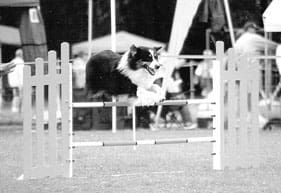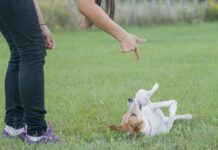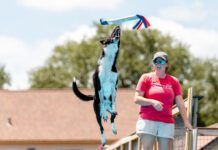[Updated February 5, 2019]
Dogs love a good massage. If you don’t believe me, ask any dog. Slow rhythmic massage moves can improve circulation, reduce stress, and relieve discomfort from a recent injury or a chronic condition like arthritis.
But there is another type of massage that we sometimes overlook. Prior to a competition, an invigorating sports massage can do wonders to get a canine athlete physically pumped and mentally psyched. This is true for any competitive endeavor whether it is lure coursing, agility, obedience, Frisbee, fly-ball, tracking, herding, field trials, or some other activity. After the competition, the dog can definitely benefit from another, more relaxing sports massage.
Trainers routinely have human and equine athletes stretch and exercise to warm up in preparation for a strenuous competition. Afterward, they cool down by walking out and perhaps doing a few more stretches.

So why do we often see a canine athlete go straight from his crate into competition without the benefit of warm-up or massage? All too often, our athletic friends also go back into their crates without adequate cool-down. I believe this is just an oversight, because our canine buddies are so willing to please and so slow to complain. Because they are so agreeable, we sometimes neglect to provide them with a proper warm-up and cool-down. Perhaps we just forget to treat them like the athletes that they are. The truth is our canine friends can benefit greatly from a pre-competition warm- up and a sports massage and a post-exercise cool-down and another sports massage.
I maintain that all dogs are athletes so we shouldn’t forget our often unsung canine companions who are ever-ready to chase a ball or a squirrel. This is hard work, too. Then there are our older friends who may have slowed a bit, but who are all tail wags when it comes time for a leisurely walk with their human. These pals can also benefit from sports massage before and after their activities.
Pre-Competition Massage for Dogs: Be Light and Quick
We have presented a number of massage techniques in our massage series and explained how they could be used to promote relaxation, soothe sore muscles, or enhance range of motion. Many of these same techniques can be incorporated into sports massage routines to invigorate the canine athlete before a competition and to relax him after he crosses the finish line. By changing your intention, your touch, and your speed, you can accomplish a totally different result with massage moves you have already learned.
When you set your intention for a routine relaxation massage, it is usually to relax the dog’s muscles, to decrease stress, and/or to address a specific physical problem. Sports massage requires a slightly different mindset. The intent for a pre-competition massage might be to warm the tissues and help the dog move freely. After competition, the intent for a post-competition massage might be to relax the dog and help him cool out. In either case, it is a good idea to think the dog’s name and a positive thought about the massage.
For example, before a lure coursing competition, I might think to my dog, “Gabbie, this massage will warm your muscles and get you ready to run.” Sometimes it works well to think in pictures that portray the benefits of the massage. You might picture your dog feeling good during and after the massage and competing with zest. Help your dog be physically and mentally ready for the job at hand. When you are preparing for the post-competition massage, picture a job well done (regardless of his place in the competition) and the dog becoming relaxed.
The touch or pressure for sports massage is generally light and the movements are quick. Slower, deliberate movements are great to induce the deep relaxation of a maintenance massage.
Don’t Forget Your Dog’s Exercise Warmups
Pre-competition massage is not a substitute for an actual physical warm-up for the dog, but it can reduce warm-up time and help the dog prepare for the task ahead. The massage should increase circulation, reduce muscle tension, and increase flexibility. This helps muscles work more efficiently and to enhance the athlete’s sense of well-being.
A warm-up massage should be relatively light and nonspecific. Do not spend too long on any body area. The idea is to warm the muscles, but you do not want to massage them to the point of total relaxation which will make them flaccid. This is an exercise in stimulation and is not the time for the muscles or the dog to become relaxed. It goes without saying that the dog should be standing for the pre-competition massage. The entire pre-competition massage should take 5 to 10 minutes.
Post-Competition Massage
The post-competition massage can be very similar to the pre-competition massage with a few changes. First, each area of the body should be opened and also closed with effleurage. The pressure should be moderate and the general speed of the massage should be a bit slower than for a pre-competition massage. The average post-competition sports massage should take about 10 to 15 minutes, which is still much shorter than a regular maintenance massage. Since the dog has just completed a hard work out, the idea is to promote general relaxation, reduce muscle tension, relieve swelling, and help prevent soreness.
Agility: A Fun, Fast Sport for Good Sports
Agility is a sport in which a handler directs her dog over a timed obstacle course. Dogs race against the clock as they jump hurdles, scale ramps, burst through tunnels, traverse a see-saw and weave through a line of poles. With scoring based on “faults,” similar to equestrian show jumping, dog agility has become an exciting spectator event. Best of all, any breed of dog (including mixedbreeds) can compete; the dog’s height determines its division.
The sport was originally developed in Great Britain, but there are several organizations in the U.S. that promote agility and organize competitions, the first and largest of which is the United States Dog Agility Association (USDAA). In addition, many clubs form on the local level to provide members with shared training facilities (including obstacles) and assistance in training their dogs.
Though agility is a competitive, athletic sport, the USDAA also promotes dog agility as a community sport, as it offers families a fun alternative for spending quality time with their pet. The obstacles are relatively easy to train, and a dog can do reasonably well and have fun without the hours of training required in other competitive canine activities; however, as with any sport, considerable time and energy is required to be highly competitive.
Whole Dog Journal‘s Canine Massage Series
Massaging Your Dog Promotes Circulation and Well Being
Petrissage: Another Massage Technique for Your Dog
Canine Massage Used for Damaged Muscle Tissue
Stretching Your Dog Reduces the Chance of Muscle Tears
Compression Techniques for Muscle Strength
Mastering Canine Massage Skills
Sue Furman is an Associate Professor in the Department of Anatomy and Neurobiology at Colorado State University in Ft. Collins, CO. She is also active as a free-lance writer and teaches canine and equine massage classes.






